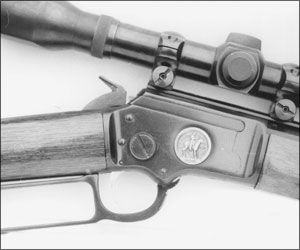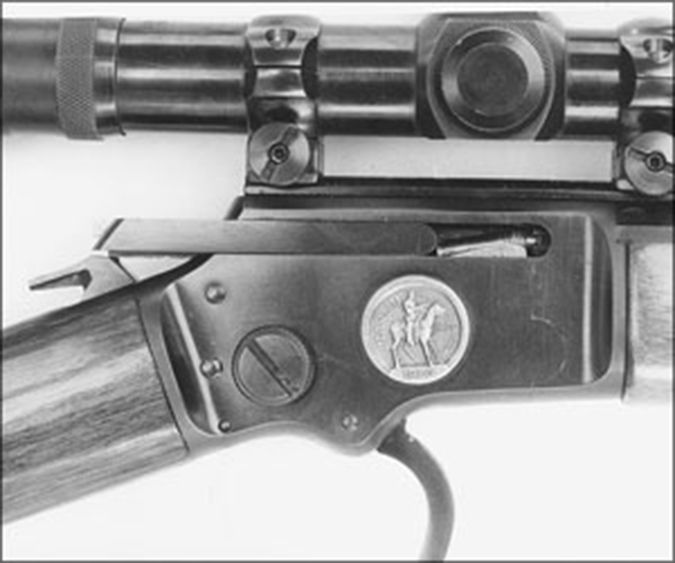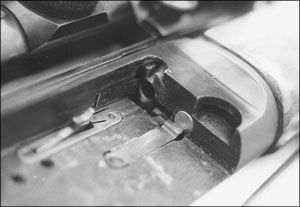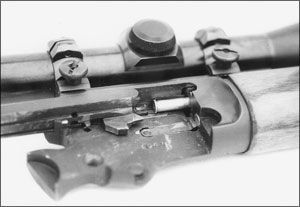
Before we get into the causes and cures of feeding problems on the tube-fed Marlin rimfires, I should start with a few cautions. First, with any exposed-hammer-style rifle, whether it’s cocked on action-opening or by thumb, careful practice must be followed in letting the hammer down to the safe position on a loaded chamber. Second, although it’s commonly assumed that jacking the finger lever repeatedly will empty all the cartridges from these rifles, cartridges can hang up during working of the lever and feeding operation. Therefore, the mag tube might not be empty even if the lever is worked several times after seeing what is assumed to be the last cartridge being ejected from the side ejection port.
On several occasions, customers have brought me these rifles after discovering a cartridge hang-up after “clearing” the rifle by repeatedly working the finger lever. And I have personally experienced this problem with at least two Marlin Model 39 rifles. The latest one was a Model 39 Century Limited made in 1970, which I’m using in preparing this article. This rifle has had less than two full boxes of cartridges put through it, and the action is like new in every respect.
I was using some Federal Hi-speed .22 Long Rifle ammunition in the rifle when I discovered the problem. I had loaded 10 rounds into the magazine and fired five. I then worked the lever five times but only four cartridges were ejected. I repeatedly worked the lever, but the fifth cartridge was not loaded or ejected. Then, as I viewed the open action while working the lever again, I saw the last cartridge being chambered. This caused me great concern—especially since this was not the first time I’d encountered this problem. In fact, I made mention of this condition in an article in American Rifleman as far back as February 1978 when I first encountered this trouble.
Searching for Cartridge Hangup And Feed Problems

A careful observation of the Marlin 39 rimfire reveals no apparent mystery in its design or overall operation. With the magazine loaded and the bolt closed, side pressure from the bolt depresses the cartridge stop, allowing a loaded round to rest against the bolt tang ready for loading. As the lever is lowered 45 degrees from closed, the bolt opens sufficiently for the rifle hammer to be cocked. With further lever travel, at 65 degrees the bolt is fully open. Backward and upward movement of the lever then causes the carrier to elevate the cartridge and the internal tip of the lever pushes the cartridge into position where the bolt can bring it to full chambering. The forward cam on the lever serves as a bolt-locking lug at full closing.
This brings me to my third caution and the crux of the problem that both the gunsmith and the gun owner must be aware of. With manipulation of the Marlin’s finger lever, it’s possible to work the lever just enough to cock the hammer and extract and eject a cartridge; but unless the lever is fully opened and an audible click is heard releasing a new cartridge into the carrier, a new shell won’t be chambered. It may be reasonable for shooters unloading this type of rifle to believe that all cartridges are cleared from the action, when this is clearly not always the case.
Opening the finger lever and initiating a rearward bolt movement of 0.861 inch is sufficient to fully cock the hammer. But—if the bolt is closed from this position—the rifle will not chamber a cartridge ready to be fired. A complete opening of the bolt via the finger lever is required for entry of a cartridge into the carrier for loading. This is so critical that a total bolt opening of 1.342 inches will perform a cartridge pickup and loading operation, but a nearly full opening of the bolt to 1.335 inches will not. This is one reason why it is often assumed the rifle is empty when it is not.
Further, a complete closing of the bolt is required for a cartridge to move freely past the cartridge stop against the bolt tang in preparation for loading the cartridge. The slightest amount of dirt or debris at the front of the bolt and chamber area will cause closing problems. Failure to fully close the finger lever will result in the same malfunction. Again, just a few thousandths of bolt travel makes a significant difference.

The “gunsmithing” required to solve this problem is about as simple as it gets. Disassembly and cleaning of the magazine tube, spring, and plunger will usually do the trick. This should be followed by a light coat of non-congealing oil as a wipe on the internal parts. As the magazine is serviced, you can also stretch the spring a couple of inches to help provide additional force on the cartridges inside the magazine. This is especially helpful as the last few cartridges are pushed into the carrier at the extreme length of the compressed spring. A severely weakened, damaged, or broken spring should be replaced. I would also advise owners to avoid leaving the magazine tube fully loaded for extended periods of time, as this will compress the spring and can weaken it.
Conclusion
The Marlin lever-action rimfire rifles like the Model 39 are deservedly popular because they’re fun to shoot. But they must be cycled properly to avoid incidents of cartridge hang-up with a resultant failure to chamber. Your customers who own these rifle should be cautioned that complete opening and closing of the finger lever is absolutely necessary for safe operation.
In addition, the rifle should be taken down regularly, cleaned, and inspected. And finally, you might mention that the use of heavily waxed bullets, particularly at cooler temperatures, means that cartridge feeding and function must be even more closely observed.






























